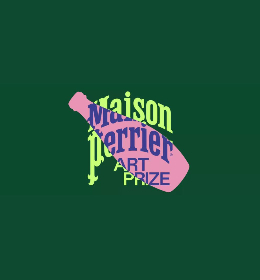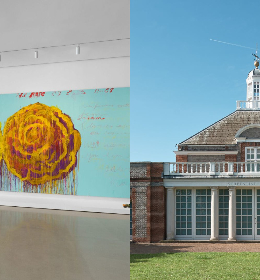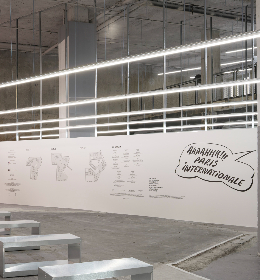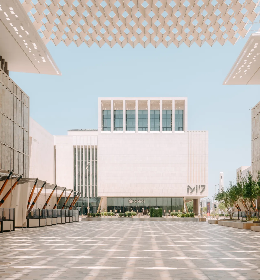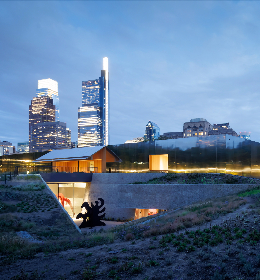Within the majestic site of the Romanesque abbey of Jumièges, two exhibitions: "A Roof of Silence", an installation by the Lebanese architect Hala Wardé and "Au bord du monde, vivent nos vertiges", a panorama of Lebanese photography curated by Clémence Cottard Hachem and Laure d'Hauteville. Through these two presentations, the visitor (re)discovers the richness of the Lebanese heritage and the vivacity of contemporary creation.

A Roof for Silence de Hala Wardé, Abbaye de Jumièges, 2022 © MD
A Roof of Silence
For her installation in the heart of the ruins of the former Benedictine abbey, Hala Wardé started from a work (poetry-painting) by Etel Adnan Olivéa : Hommage à la déesse de l'olivier, 16 tondos paying homage to the 16 thousand-year-old olive trees found in Bchaaleh in the Batroun region, and considered to be the oldest in the world. It is said that the olive branch brought by the dove to Noah came from these trees. Etel Adnan loved this story and worked in collaboration with Hala Wardé who represented Lebanon at the 17th Venice Architecture Biennale in 2021. Etel Adnan, who died in November 2021, will not have been able to see the medieval setting chosen by Wardé for her installation, which she wished to tour (the Palais de Tokyo has presented a film by Alain Fleischer and the original tondos until July 24). By inviting several artists to imagine a "roof for silence", Hala Wardé pays homage to Lebanon's multi-millennial heritage and to the victims of the explosion in the port of Beirut on 4 August 2020.

A Roof for Silence de Hala Wardé, Abbaye de Jumièges, 2022 © MD
This link between past and present is perceptible as soon as one enters what used to be the narthex: the Antiforms by Paul Virilio, architect and theorist of speed, and 16 black and white photographs of these 16 thousand-year-old olive trees by Fouad Elkoury, which, once passed, lead us to the nave, where broken glass collected during the explosion in the harbour shows us the way to the transept, choir and apse, where we reach the heart of the installation. Etel Adnan's tondos have been transcribed into ceramics by the Norman ceramist Alexandra Catelain-Orange of the Pôle Céramique and each one is presented in the axis of an olive tree of Bchaaleh. Installed in front of it, a gigantic faceted mirror reflects the sky, connects the earth and the sky and replaces the roof of the abbey, but also symbolises the roofs that the Beirut inhabitants lost on 4 August 2020.
Accompanying the central installation, the singer Mika declaims Etel Adnan's poems in a staging designed by the Sound Walk collective.
At the edge of the world, lives our vertigo
The former abbey house of Jumièges welcomes a selection of 16 Lebanese photographers and video artists: Joanna Andraos, Valérie Cachard & Grégory Buchakjian, Jack Dabaghian, Rami El Sabbagh, Paul Gorra, Joana Hadjithomas and Khalil Joreige, Gilbert Hage, Laetitia Hakim & Tarek Haddad, Roger Moukarzel, Nasri Sayegh, Caroline Tabet, Lara Tabet, Tanya Traboulsi.
They bear witness to their reality in a country full of paradoxes. Marked by the explosion, these artists try to exorcise the traumas of an entire people. Destructions and reconstructions characterise Lebanon, a country of paradoxes and a laboratory for the challenges facing the planet: disappearance of water resources, migrations, political and economic crises...
Artists are often the first to bear witness to the threats, like Jack Dabaghian who, through his series "Sentinels", warns of the disappearance of ecosystems. With The death of the cedar, he warns of the disappearance of this tree, a symbol of Lebanon, a dying tree whose roots still hold it to the ground in the Maasser El Chouf reserve.

Ouyoune Al Simane, 2019, Paul Gorra © Paul Gorra

De la série Beirut recurring dream, 2021, Tanya Traboulsi © Tanya Traboulsi
The duo Joanna Hadjithomas and Khalil Joreige have been reflecting on the archaeology of cities and the traces of the past for several years. Here, three photographs from their project Unconformities present a core sample taken in a huge landfill in Tripoli, which has been active for more than twenty years and has completely transformed the surrounding landscape. We know the recurrent waste crisis in Lebanon and here the samples taken according to the scientific methods of archaeologists are witnesses of the various occupations of the site and inform us about the way of life of the inhabitants (analysis of waste, its type, its quantity...)

Joana Hadjithomas & Khalil Joreige, A State (BH1), 2019, Du projet UNCONFORMITIES; Tirage jet d’encre pigmentaire © Joana Hadjithomas & Khalil Joreige
Joanna Andraos, who is also a psychoanalyst, presents her series "Anatomy of Feelings" in which we discover what remains after an analysis session. These scraps are full of tears, fears but also hope. By collecting these tears locked in the handkerchiefs she photographs, she restores what is hidden and hidden. The analytical work through words allows the fears to be exorcised, thus encouraging the victims to speak.

Joanna Andraos, Anatomie des Sentiments, 2022 Tirage jet d’encre pigmentaire © Joanna Andraos
"A Roof of Silence. Installation by Hala Wardé with Etel Adnan, Pôle Céramique Normandie, Fouad Elkoury, Soundwalk Collective and Mika — Abbaye de Jumièges, until 6 November 2022
"At the edge of the world, live our vertigo. A look at the Lebanese contemporary photography scene". Curated by Clémence Cottard Hachem and Laure d'Hauteville — Abbaye de Jumièges until 6 November 2022.
Cover image: La mort du Cèdre, Maasser el Chouf, 2021, Jack Dabaghian © Jack Dabaghian





